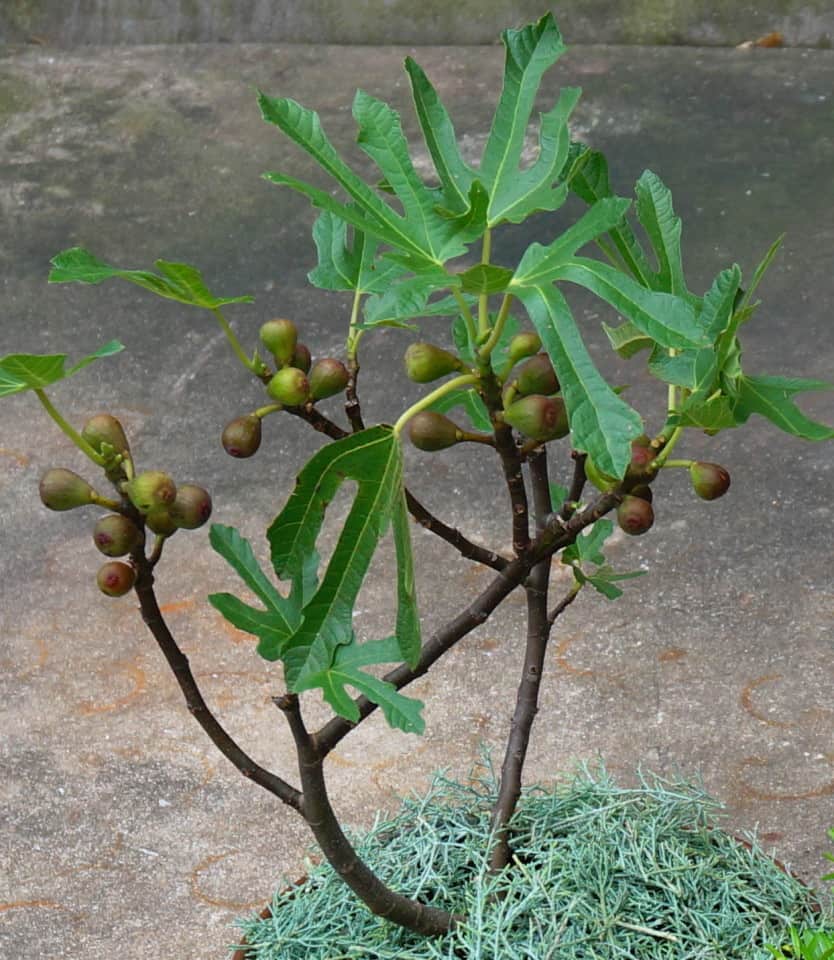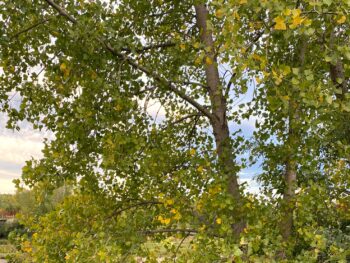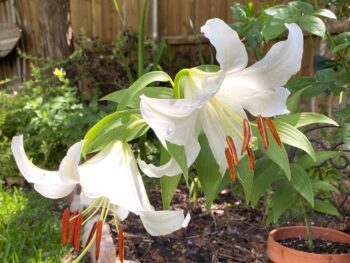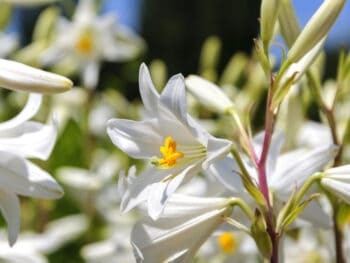Looking to add a little love to your garden or patio this fall? No doubt you will grow hopelessly fond of two patented plants recently introduced by trusted brands: Southern Living Plant Collection, showcasing Ficus carica ‘Little Miss Figgy,’ and Proven Winners, revealing Punica granatum ‘Peppy Le Pom’™. This Miss-and-Mister make a great match for the patio or focal point in the garden, a darling pairing of fig and pomegranate that drawing us into the Bible in a tale of romance and celebration.
Ladies First
‘Little Miss Figgy’ is a fabulous cultivar for bringing the Bible’s first-mentioned fruit tree to the home garden. Its dwarf stature makes it manageable, maturing to a reasonable height of 4 to 8 feet, with branches and leaves growing in diminutive scale. The petite fig will enjoy your sunniest spot without complaint, and require a relatively modest amount of watering compared to other planters.

Prolific figs cover the plant in spring and fall with an intensely brown-purple display. I recommend keeping netting on hand to cover the little tree when fruits are in their prime to discourage birds from feasting first! Tree-ripened fruits make a sweet, pop-in-your-mouth treat you will not find in stores.
For more garden care specifics, click here to Southern Living Plants ‘Little Miss Figgy’
Meet the Mister
Peppy Le Pom™ is a prized pomegranate plant, introducing this Holy Land small tree as a compact, small-leaved shrub. It blooms abundantly with bright, attention-getting, poppy-red flowers spring to fall. Full growth puts the plant at about 3 feet tall by 3 feet wide, an appropriate patio size, although it is easily pruned to keep more compact or shaped into topiary.

Flowers give way to dainty, mini-sized fruits—fun, decorative, and edible, yet too tiny to be truly tasty. Instead the constant display of cheery, dangling flowers is Peppy’s greatest charm, and equally delightful is the dazzle of bright, golden leaves before this deciduous tree goes winter-bare.
For more garden care specifics, click here to Proven Winners Peppy Le Pom™
A Match Made in Heaven
Most couples will agree they have fallen head-over-heels for their opposite—my husband relishes my calm, wallflower nature even as I love how his laughter and storytelling ignites a room. A quick glance will size up this fruited pair’s differences—Miss Figgy taller, on the lanky side; Mr. Peppy squat and bushy. “She” has fruit attractive and intriguing, while “He”* has flowers show-stopping.
Yet like most couples, their contrasting qualities become an expansive, united whole, and differences become beautiful compliments filling out each other’s lives in a more complete way…all the while ensuring unending, lively exchange! Let ‘Little Miss Figgy’ add height and sculptural drama to your patio plantings, and Peppy Le Pom™ can punctuate the center of its pot. This fig’s fruits will peak attention at the beginning and end of patio season, and the dwarf pomegranate will supply zinnia-bold color over the long haul of summer.
Find Fig and Pursue Pomegranate in the Bible
Likewise, each fruit offers unique insight into God’s love through their appearances in Bible stories. Fig trees are first sighted amid controversy, supplying leaves to clothe the couple gone astray from the Lord God’s covering (Genesis 3:7), a tension echoed in Jesus’ fury at the fruitless fig tree (Mark 11:13-14).What love relationship does not experience feisty conflicts?? Nevertheless, fig trees remain an enduring symbol of the Lord’s assurance of tranquility and success in this favored passage, where a peaceful nation offers its individuals opportunity for fruitful endeavors:
‘…In that day,’ declares the Lord of hosts, ‘every one of you will invite his neighbor to sit under his vine and his fig tree [enjoying peace and prosperity in the kingdom].’”
Zechariah 3:10 AMP
Meanwhile pomegranates, with pleasing, perky flowers and fruits dotting glossy green canopies, are a sign of blessing, abundance, and merriment, as vibrant decorations of everything from priests’ robes to palace architecture (Exodus 39:26, 1 Kings 7:42). Pomegranate points to the upbeat, flirty cheer of God’s love, essential to every lively marriage—
Let us go early to the vineyards to see if the vines have budded, if their blossoms have opened, and if the pomegranates are in bloom—there I will give you my love.
Song of Songs 7:12 NIV
—the smitten brilliance of being playful, co-adventurers with the one you love.
Fig and Pomegranate Together
Where both fruits are written about together, we are called to notice God’s assured provision in totality to His people in the land He promised to them. First, the produce pair is discovered by Israelite spies among the fruiting treasures as they scouted their future home:
When they reached the Valley of Eshkol, they cut off a branch bearing a single cluster of grapes. Two of them carried it on a pole between them, along with some pomegranates and figs.
Numbers 13:23 NIV
Next, fig and pomegranate are cited among the “Seven Species,” the famous plant list of guaranteed, gracious sustenance for God’s people:
For the Lord your God is bringing you into a good land—a land with brooks, streams, and deep springs gushing out into the valleys and hills; a land with wheat and barley, vines and fig trees, pomegranates, olive oil and [date] honey.
Deuteronomy 8:7-8 NIV
Other mentions of fig and pomegranate together (Numbers 20:5, Joel 1:12, Haggai 2:19) reference back to this endearing provision list; in later years where the fruits had withered or their harvests failed, such lackluster yield was a sign of their failure to remain faithful to God. It was tangible evidence to remind them to return to the God in whose love they would be sheltered and secure. In other words, the abundance of the fruits, like figs and pomegranates, and productive livelihoods in the land would be a reflection of the people’s flourishing love for their Lord.
Time to Celebrate!
More than a promise of Levant-region favorites to be plentiful in the Israelites new home, the Seven Species were a subtle directive for the three appointed, annual engagements with the Lord.
Three times a year you are to celebrate a festival to me.
Exodus 23:14 NIV
But how do fig, pomegranate, and the other fruits reveal the festivals? Through the timing of their harvests. The first festival, Passover, Pesach, occurred at the time of the barley harvest (Exodus 9:31 & Deuteronomy 16:1); the next festival, Pentecost, Shavout, coincided with the time of the wheat harvest (Exodus 9:32 & Leviticus 23:15-16); and Tabernacles, Sukkot, in the fall, came after the time when all the fruits had come in (Leviticus 23:29, Deuteronomy 16:13).
While the trademark plants for celebrating Sukkot are the branches of palm, myrtle, and willow trees (Leviticus 23:40, Nehemiah 8:15), bound in a lulav; still, the laden tables in the eight nights of festive celebration are abundant with the fall fruits, fig and pomegranate among them.
These festivals or feasts are sacred traditions in the Jewish faith, yet hold equally holy regard for those who believe in Jesus, the Messiah: His crucifixion and resurrection occurred at the time of Passover (His Last Supper was Passover dinner, John 13:1-2); His Holy Spirit came to fill followers on Pentecost (Acts 2:1-2); and we have every reason to watch for His comeback (Acts 1:10) at the time of Tabernacles.
Learn more about the Feast of Tabernacles
Final Word & Prayer
We might say the Lord scheduled “date nights” with His people—it’s a stretch, I know, but what else do you call an appointment between two who love each other, God and His people, and look forward to spending joyful time together? The festivals or feasts offer a time to set aside cultivating and other regular work, to be reassured in His unfolding plan, enjoy fellowship with family and friends, and rest happily in His Presence.
As these fall nights linger and twinkle in the last moments of our long summer, let ‘Little Miss Figgy’ and Peppy Le Pom™ bless you in God’s Word, planting His love story right on your patio.
Prayer: O Lord, thank you for these plants that can serve as signposts in your Word to the deep, everlasting reality of your love. You reassured your people of your devotion by blessing them with delicious fruits, and I am your people, too! You are faithful and unchanging, and the ancient patterns of provision and appointments and celebration are mine to watch for and embrace today.
“Shout and be glad, Daughter Zion. For I am coming, and I will live among you,” declares the Lord.
Zechariah 2:10 NIV

Thank you to Southern Living Plant Collection and friends at Plant Development Services for the sample of ‘Little Miss Figgy’ to trial in my garden. For more information and directory to a retailer near you, visit
www.southernlivingplants.com/shrubs/plant/little-miss-figgy-dwarf-fig

Likewise, Proven Winners was generous to supply Peppy Le Pom™ to all who attended GardenComm Annual Conference #GardenComm2019 and the inspiration for this story. For more information visit
www.provenwinners.com/plants/punica/peppy-le-pom-pomegranate-punica-granatum

Read more in God’s Word for Gardeners Bible! Figs are discussed in “Restoring Bitter to Sweet,” and “Fruiting, Not Leaving,” in Leaving the Garden of Eden devotions, beginning on page a-12
Pomegranates are detailed in “Wonderful Blessing,” in the Bearing Fruit devotions series beginning on page a-34
Quickly locate all mention of figs and pomegranates in God’s Word for Gardeners Bible by using the Plant Index

For more how-to planting tips and garden-to-table goodness, go to the Plant Guide:
gardendelight.wpengine.com/plant-guide/fig/
gardendelight.wpengine.com/plant-guide/pomegranate/
*“She” and “He” are intended as a parody of patterning the names of these cultivars after the lovers’ banter in Song of Songs; fig and pomegranate plants are not botanically one sex or the other, that is, dioecious.
Photo Credits:
©2019 Shelley S. Cramm














